2019 MERCEDES-BENZ SL CLASS brake
[x] Cancel search: brakePage 63 of 330
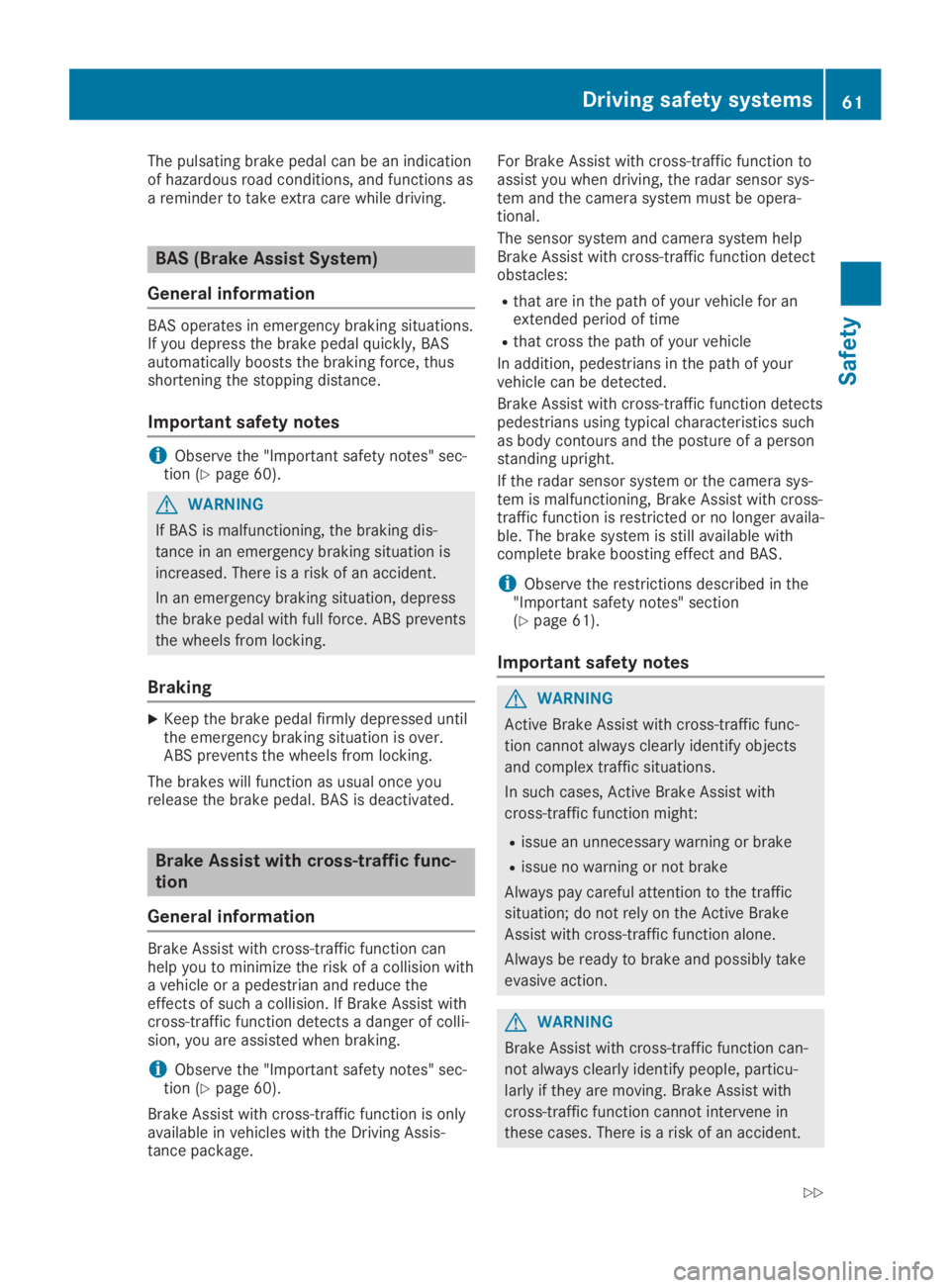
The pulsating brake pedal can be an indicationof hazardous road conditions, and functions asa reminder to take extra care while driving.
BAS (Brake Assist System)
General information
BAS operates in emergency braking situations.If you depress the brake pedal quickly, BASautomatically boosts the braking force, thusshortening the stopping distance.
Important safety notes
iObserve the "Important safety notes" sec-tion (Ypage 60).
GWARNING
If BAS is malfunctioning, the braking dis-
tance in an emergency braking situation is
increased. There is a risk of an accident.
In an emergency braking situation, depress
the brake pedal with full force. ABS prevents
the wheels from locking.
Braking
XKeep the brake pedal firmly depressed untilthe emergency braking situation is over.ABS prevents the wheels from locking.
The brakes will function as usual once yourelease the brake pedal. BAS is deactivated.
Brake Assist with cross-traffic func-
tion
General information
Brake Assist with cross-traffic function canhelp you to minimize the risk of a collision witha vehicle or a pedestrian and reduce theeffects of such a collision. If Brake Assist withcross-traffic function detects a danger of colli-sion, you are assisted when braking.
iObserve the "Important safety notes" sec-tion (Ypage 60).
Brake Assist with cross-traffic function is onlyavailable in vehicles with the Driving Assis-tance package.
For Brake Assist with cross-traffic function toassist you when driving, the radar sensor sys-tem and the camera system must be opera-tional.
The sensor system and camera system helpBrake Assist with cross-traffic function detectobstacles:
Rthat are in the path of your vehicle for anextended period of time
Rthat cross the path of your vehicle
In addition, pedestrians in the path of yourvehicle can be detected.
Brake Assist with cross-traffic function detectspedestrians using typical characteristics suchas body contours and the posture of a personstanding upright.
If the radar sensor system or the camera sys-tem is malfunctioning, Brake Assist with cross-traffic function is restricted or no longer availa-ble. The brake system is still available withcomplete brake boosting effect and BAS.
iObserve the restrictions described in the"Important safety notes" section(Ypage 61).
Important safety notes
GWARNING
Active Brake Assist with cross-traffic func-
tion cannot always clearly identify objects
and complex traffic situations.
In such cases, Active Brake Assist with
cross-traffic function might:
Rissue an unnecessary warning or brake
Rissue no warning or not brake
Always pay careful attention to the traffic
situation; do not rely on the Active Brake
Assist with cross-traffic function alone.
Always be ready to brake and possibly take
evasive action.
GWARNING
Brake Assist with cross-traffic function can-
not always clearly identify people, particu-
larly if they are moving. Brake Assist with
cross-traffic function cannot intervene in
these cases. There is a risk of an accident.
Driving safety systems61
Safety
Z
Page 64 of 330
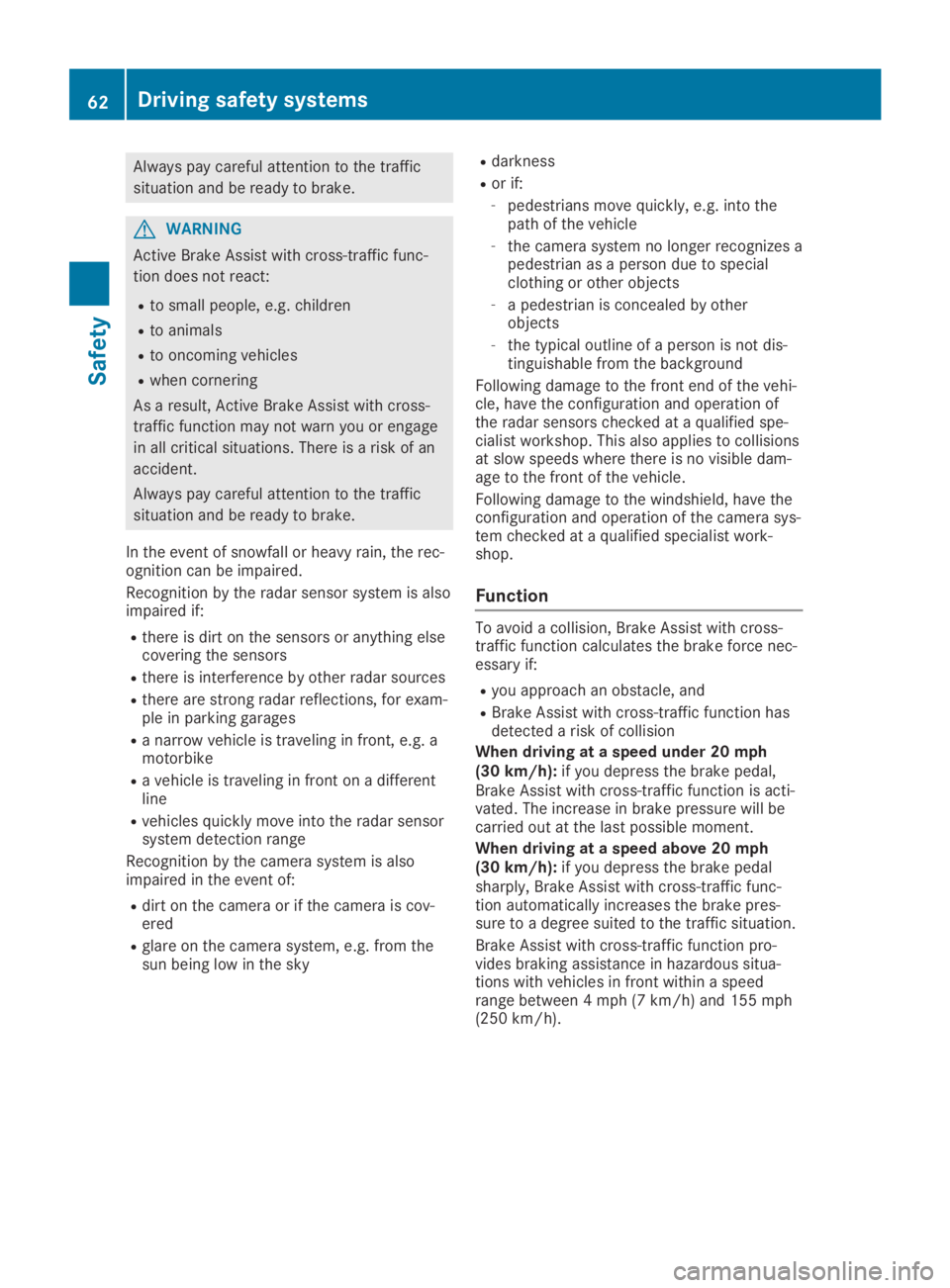
Always pay careful attention to the traffic
situation and be ready to brake.
GWARNING
Active Brake Assist with cross-traffic func-
tion does not react:
Rto small people, e.g. children
Rto animals
Rto oncoming vehicles
Rwhen cornering
As a result, Active Brake Assist with cross-
traffic function may not warn you or engage
in all critical situations. There is a risk of an
accident.
Always pay careful attention to the traffic
situation and be ready to brake.
In the event of snowfall or heavy rain, the rec-ognition can be impaired.
Recognition by the radar sensor system is alsoimpaired if:
Rthere is dirt on the sensors or anything elsecovering the sensors
Rthere is interference by other radar sources
Rthere are strong radar reflections, for exam-ple in parking garages
Ra narrow vehicle is traveling in front, e.g. amotorbike
Ra vehicle is traveling in front on a differentline
Rvehicles quickly move into the radar sensorsystem detection range
Recognition by the camera system is alsoimpaired in the event of:
Rdirt on the camera or if the camera is cov-ered
Rglare on the camera system, e.g. from thesun being low in the sky
Rdarkness
Ror if:
-pedestrians move quickly, e.g. into thepath of the vehicle
-the camera system no longer recognizes apedestrian as a person due to specialclothing or other objects
-a pedestrian is concealed by otherobjects
-the typical outline of a person is not dis-tinguishable from the background
Following damage to the front end of the vehi-cle, have the configuration and operation ofthe radar sensors checked at a qualified spe-cialist workshop. This also applies to collisionsat slow speeds where there is no visible dam-age to the front of the vehicle.
Following damage to the windshield, have theconfiguration and operation of the camera sys-tem checked at a qualified specialist work-shop.
Function
To avoid a collision, Brake Assist with cross-traffic function calculates the brake force nec-essary if:
Ryou approach an obstacle, and
RBrake Assist with cross-traffic function hasdetected a risk of collision
When driving at a speed under 20 mph(30 km/h):if you depress the brake pedal,Brake Assist with cross-traffic function is acti-vated. The increase in brake pressure will becarried out at the last possible moment.
When driving at a speed above 20 mph(30 km/h):if you depress the brake pedalsharply, Brake Assist with cross-traffic func-tion automatically increases the brake pres-sure to a degree suited to the traffic situation.
Brake Assist with cross-traffic function pro-vides braking assistance in hazardous situa-tions with vehicles in front within a speedrange between 4 mph (7 km/h) and 155 mph(250 km/h).
62Driving safety systems
Safety
Page 65 of 330
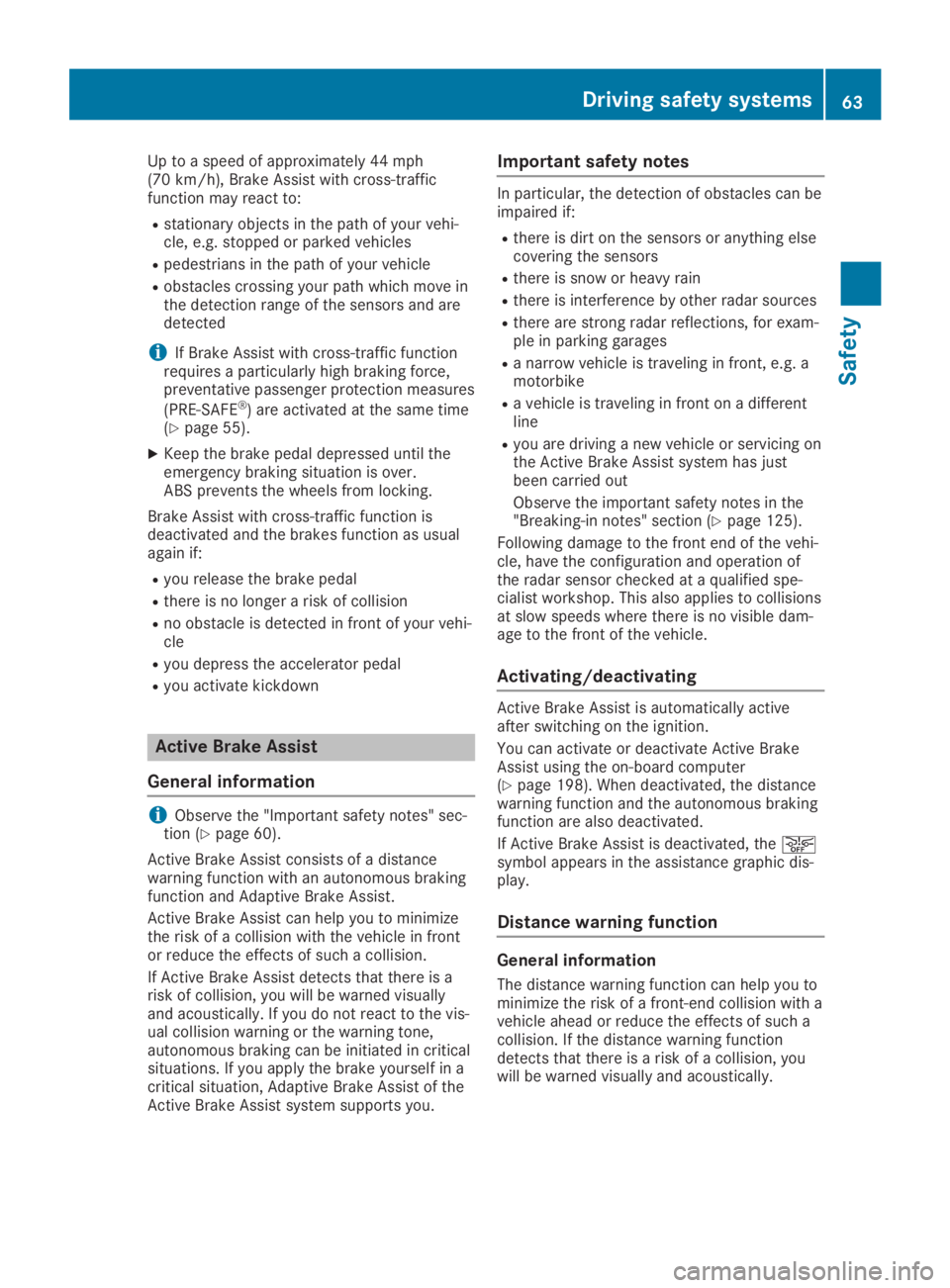
Up to a speed of approximately 44 mph(70 km/h), Brake Assist with cross-trafficfunction may react to:
Rstationary objects in the path of your vehi-cle, e.g. stopped or parked vehicles
Rpedestrians in the path of your vehicle
Robstacles crossing your path which move inthe detection range of the sensors and aredetected
iIf Brake Assist with cross-traffic functionrequires a particularly high braking force,preventative passenger protection measures
(PRE-SAFE®) are activated at the same time(Ypage 55).
XKeep the brake pedal depressed until theemergency braking situation is over.ABS prevents the wheels from locking.
Brake Assist with cross-traffic function isdeactivated and the brakes function as usualagain if:
Ryou release the brake pedal
Rthere is no longer a risk of collision
Rno obstacle is detected in front of your vehi-cle
Ryou depress the accelerator pedal
Ryou activate kickdown
Active Brake Assist
General information
iObserve the "Important safety notes" sec-tion (Ypage 60).
Active Brake Assist consists of a distancewarning function with an autonomous brakingfunction and Adaptive Brake Assist.
Active Brake Assist can help you to minimizethe risk of a collision with the vehicle in frontor reduce the effects of such a collision.
If Active Brake Assist detects that there is arisk of collision, you will be warned visuallyand acoustically. If you do not react to the vis-ual collision warning or the warning tone,autonomous braking can be initiated in criticalsituations. If you apply the brake yourself in acritical situation, Adaptive Brake Assist of theActive Brake Assist system supports you.
Important safety notes
In particular, the detection of obstacles can beimpaired if:
Rthere is dirt on the sensors or anything elsecovering the sensors
Rthere is snow or heavy rain
Rthere is interference by other radar sources
Rthere are strong radar reflections, for exam-ple in parking garages
Ra narrow vehicle is traveling in front, e.g. amotorbike
Ra vehicle is traveling in front on a differentline
Ryou are driving a new vehicle or servicing onthe Active Brake Assist system has justbeen carried out
Observe the important safety notes in the"Breaking-in notes" section (Ypage 125).
Following damage to the front end of the vehi-cle, have the configuration and operation ofthe radar sensor checked at a qualified spe-cialist workshop. This also applies to collisionsat slow speeds where there is no visible dam-age to the front of the vehicle.
Activating/deactivating
Active Brake Assist is automatically activeafter switching on the ignition.
You can activate or deactivate Active BrakeAssist using the on-board computer(Ypage 198). When deactivated, the distancewarning function and the autonomous brakingfunction are also deactivated.
If Active Brake Assist is deactivated, the�
Page 66 of 330
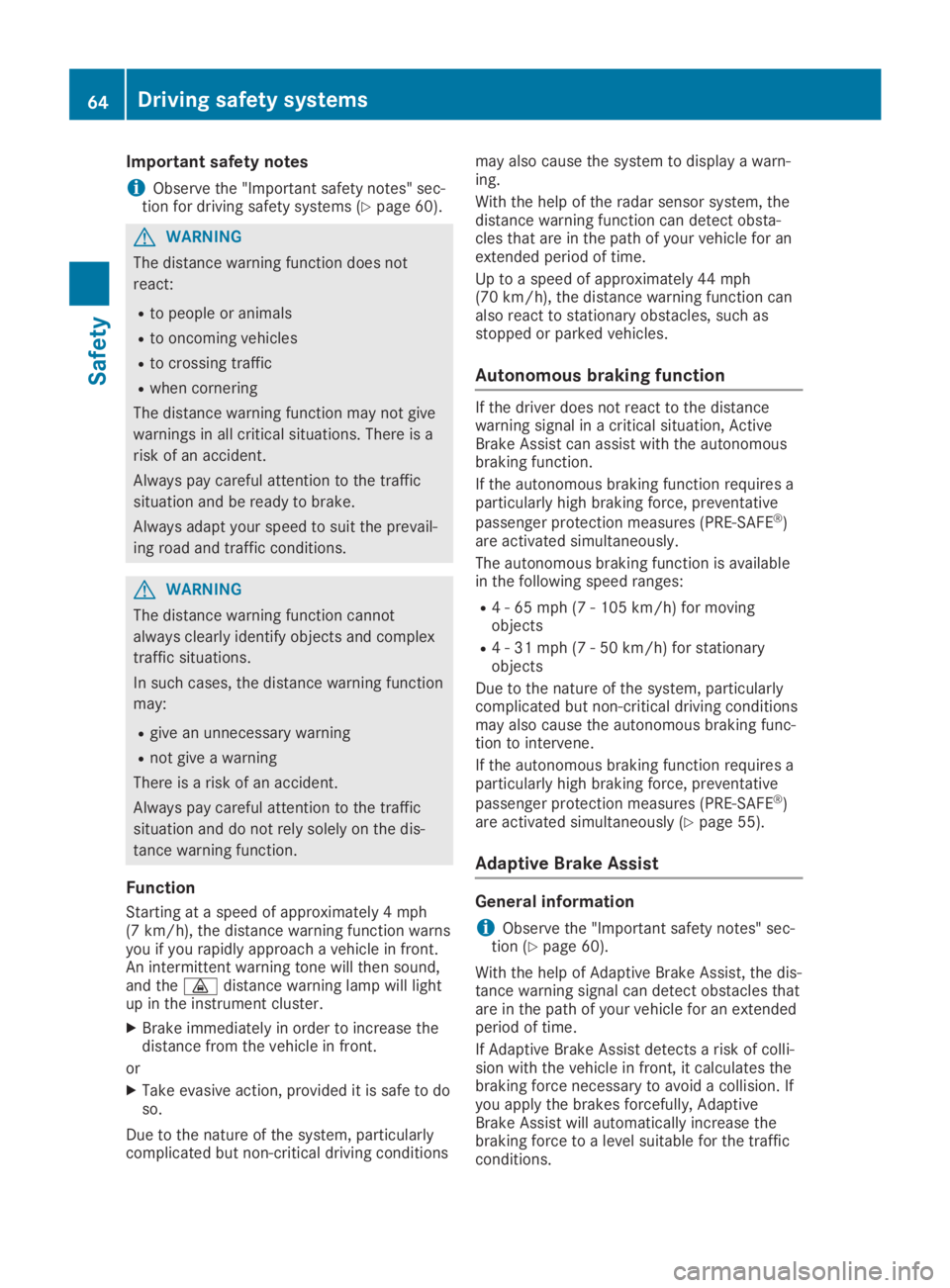
Important safety notes
iObserve the "Important safety notes" sec-tion for driving safety systems (Ypage 60).
GWARNING
The distance warning function does not
react:
Rto people or animals
Rto oncoming vehicles
Rto crossing traffic
Rwhen cornering
The distance warning function may not give
warnings in all critical situations. There is a
risk of an accident.
Always pay careful attention to the traffic
situation and be ready to brake.
Always adapt your speed to suit the prevail-
ing road and traffic conditions.
GWARNING
The distance warning function cannot
always clearly identify objects and complex
traffic situations.
In such cases, the distance warning function
may:
Rgive an unnecessary warning
Rnot give a warning
There is a risk of an accident.
Always pay careful attention to the traffic
situation and do not rely solely on the dis-
tance warning function.
Function
Starting at a speed of approximately 4 mph(7 km/h),the distance warning function warnsyou if you rapidly approach a vehicle in front.An intermittent warning tone will then sound,and the�
Page 67 of 330
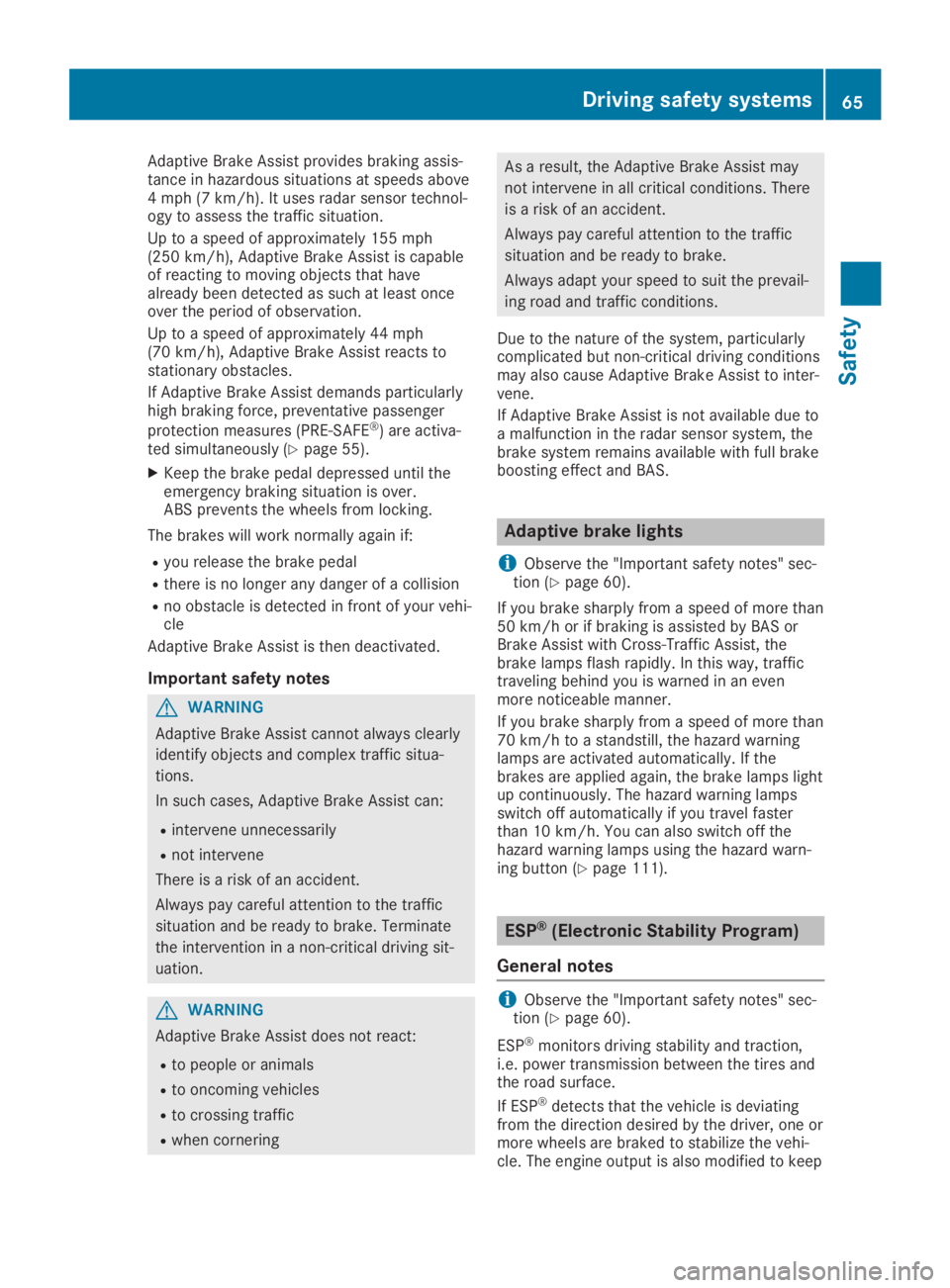
Adaptive Brake Assist provides braking assis-tance in hazardous situations at speeds above4 mph (7 km/h). It uses radar sensor technol-ogy to assess the traffic situation.
Up to a speed of approximately 155 mph(250 km/h), Adaptive Brake Assist is capableof reacting to moving objects that havealready been detected as such at least onceover the period of observation.
Up to a speed of approximately 44 mph(70 km/h), Adaptive Brake Assist reacts tostationary obstacles.
If Adaptive Brake Assist demands particularlyhigh braking force, preventative passenger
protection measures (PRE-SAFE®) are activa-ted simultaneously (Ypage 55).
XKeep the brake pedal depressed until theemergency braking situation is over.ABS prevents the wheels from locking.
The brakes will work normally again if:
Ryou release the brake pedal
Rthere is no longer any danger of a collision
Rno obstacle is detected in front of your vehi-cle
Adaptive Brake Assist is then deactivated.
Important safety notes
GWARNING
Adaptive Brake Assist cannot always clearly
identify objects and complex traffic situa-
tions.
In such cases, Adaptive Brake Assist can:
Rintervene unnecessarily
Rnot intervene
There is a risk of an accident.
Always pay careful attention to the traffic
situation and be ready to brake. Terminate
the intervention in a non-critical driving sit-
uation.
GWARNING
Adaptive Brake Assist does not react:
Rto people or animals
Rto oncoming vehicles
Rto crossing traffic
Rwhen cornering
As a result, the Adaptive Brake Assist may
not intervene in all critical conditions. There
is a risk of an accident.
Always pay careful attention to the traffic
situation and be ready to brake.
Always adapt your speed to suit the prevail-
ing road and traffic conditions.
Due to the nature of the system, particularlycomplicated but non-critical driving conditionsmay also cause Adaptive Brake Assist to inter-vene.
If Adaptive Brake Assist is not available due toa malfunction in the radar sensor system, thebrake system remains available with full brakeboosting effect and BAS.
Adaptive brake lights
iObserve the "Important safety notes" sec-tion (Ypage 60).
If you brake sharply from a speed of more than50 km/h or if braking is assisted by BAS orBrake Assist with Cross-Traffic Assist, thebrake lamps flash rapidly. In this way, traffictraveling behind you is warned in an evenmore noticeable manner.
If you brake sharply from a speed of more than70 km/h to a standstill, the hazard warninglamps are activated automatically. If thebrakes are applied again, the brake lamps lightup continuously. The hazard warning lampsswitch off automatically if you travel fasterthan 10 km/h. You can also switch off thehazard warning lamps using the hazard warn-ing button (Ypage 111).
ESP®(Electronic Stability Program)
General notes
iObserve the "Important safety notes" sec-tion (Ypage 60).
ESP®monitors driving stability and traction,i.e. power transmission between the tires andthe road surface.
If ESP®detects that the vehicle is deviatingfrom the direction desired by the driver, one ormore wheels are braked to stabilize the vehi-cle. The engine output is also modified to keep
Driving safety systems65
Safety
Z
Page 68 of 330
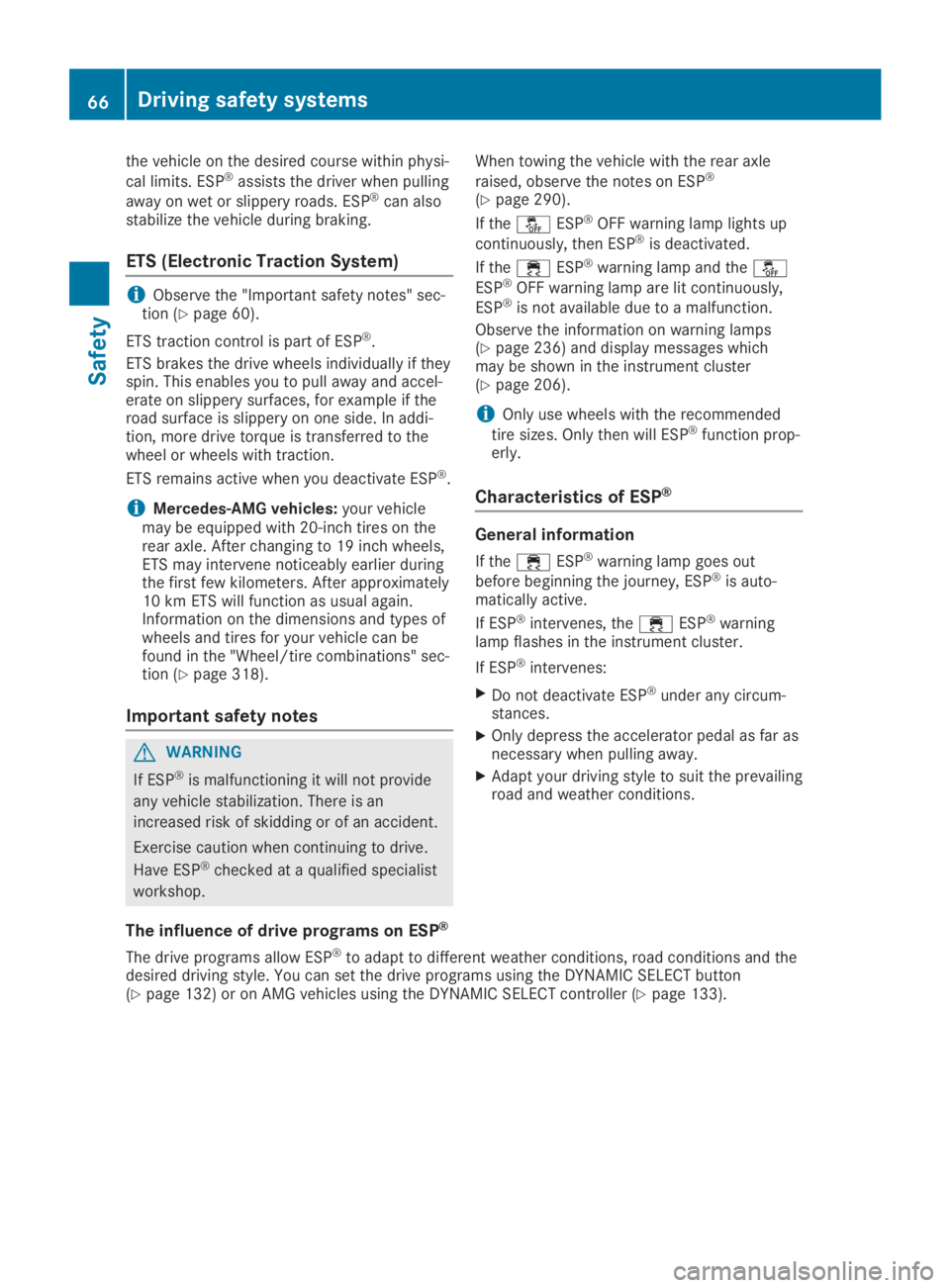
the vehicle on the desired course within physi-
cal limits. ESP®assists the driver when pulling
away on wet or slippery roads. ESP®can alsostabilize the vehicle during braking.
ETS (Electronic Traction System)
iObserve the "Important safety notes" sec-tion (Ypage 60).
ETS traction control is part of ESP®.
ETS brakes the drive wheels individually if theyspin. This enables you to pull away and accel-erate on slippery surfaces, for example if theroad surface is slippery on one side. In addi-tion, more drive torque is transferred to thewheel or wheels with traction.
ETS remains active when you deactivate ESP®.
iMercedes-AMG vehicles:your vehiclemay be equipped with 20-inch tires on therear axle. After changing to 19 inch wheels,ETS may intervene noticeably earlier duringthe first few kilometers. After approximately10 km ETS will function as usual again.Information on the dimensions and types ofwheels and tires for your vehicle can befound in the "Wheel/tire combinations" sec-tion (Ypage 318).
Important safety notes
GWARNING
If ESP®is malfunctioning it will not provide
any vehicle stabilization. There is an
increased risk of skidding or of an accident.
Exercise caution when continuing to drive.
Have ESP®checked at a qualified specialist
workshop.
When towing the vehicle with the rear axle
raised, observe the notes on ESP®
(Ypage 290).
If the�
Page 72 of 330

tics. Have the brake system checked at a
qualified specialist workshop.
Observe information regarding indicator andwarning lamps (Ypage 236) as well as displaymessages (Ypage 208).
ADAPTIVE BRAKE
iObserve the "Important safety notes" sec-tion (Ypage 60).
ADAPTIVE BRAKE enhances braking safety andoffers increased braking comfort. In additionto the braking function, ADAPTIVE BRAKE alsohas the HOLD function (Ypage 165) and hillstart assist (Ypage 129).
Active Brake Assist with cross-traffic
function
General information
Active Brake Assist with cross-traffic functioncan help you to minimize the risk of a collisionwith the vehicle in front or a pedestrian. ActiveBrake Assist with cross-traffic function canalso reduce the effects of such a collision. IfActive Brake Assist with cross-traffic functionhas detected a risk of collision, you will bewarned visually and acoustically as well as byautomatic braking.
iPay attention to the important safety notesin the "Driving safety systems" section(Ypage 60).
Active Brake Assist with cross-traffic functionis only available in vehicles with the DrivingAssistance Plus package.
For Active Brake Assist with cross-traffic func-tion to assist you when driving, the radar sen-sor system and the camera system must beoperational.
The radar sensor system and camera systemhelp Active Brake Assist with cross-trafficfunction to detect obstacles that are in thepath of your vehicle for an extended period oftime.
In addition, pedestrians in the path of yourvehicle can be detected.
Active Brake Assist with cross-traffic functiondetects pedestrians using typical characteris-
tics such as body contours and the posture ofa person standing upright.
iObserve the restrictions described in the"Important safety notes" section(Ypage 70).
Important safety notes
GWARNING
Active Brake Assist with cross-traffic func-
tion will initially brake your vehicle by a par-
tial application of the brakes if a danger of
collision is detected. There may be a colli-
sion unless you brake yourself. Even after
subsequent full application of the brakes a
collision cannot always be avoided, particu-
larly when approaching at too high a speed.
There is a risk of an accident.
Always apply the brakes yourself and try to
take evasive action, provided it is safe to do
so.
If you partially apply the brakes, the vehicle isbraked with up to 50% of the full braking force.
GWARNING
Active Brake Assist with cross-traffic func-
tion cannot always clearly identify objects
and complex traffic situations.
In such cases, Active Brake Assist with
cross-traffic function might:
Rgive an unnecessary warning and then
brake the vehicle
Rneither give a warning nor intervene
There is a risk of an accident.
Always pay particular attention to the traffic
situation and be prepared to brake, espe-
cially if Active Brake Assist with cross-traffic
function alerts you. Terminate the interven-
tion in a non-critical driving situation.
GWARNING
Active Brake Assist with cross-traffic func-
tion cannot always clearly identify people,
particularly if they are moving. Active Brake
Assist with cross-traffic function cannot
70Driving safety systems
Safety
Page 73 of 330
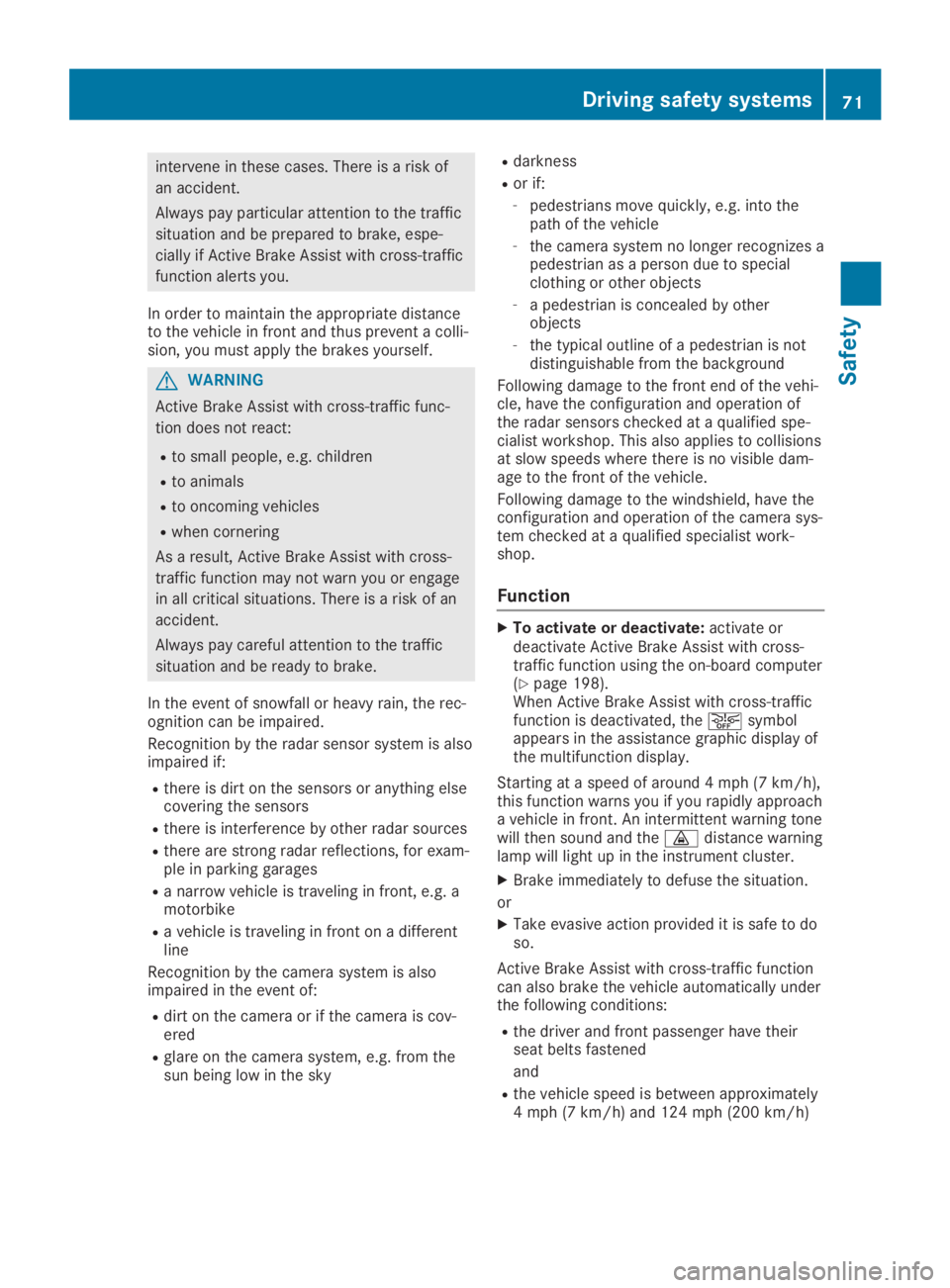
intervene in these cases. There is a risk of
an accident.
Always pay particular attention to the traffic
situation and be prepared to brake, espe-
cially if Active Brake Assist with cross-traffic
function alerts you.
In order to maintain the appropriate distanceto the vehicle in front and thus prevent a colli-sion, you must apply the brakes yourself.
GWARNING
Active Brake Assist with cross-traffic func-
tion does not react:
Rto small people, e.g. children
Rto animals
Rto oncoming vehicles
Rwhen cornering
As a result, Active Brake Assist with cross-
traffic function may not warn you or engage
in all critical situations. There is a risk of an
accident.
Always pay careful attention to the traffic
situation and be ready to brake.
In the event of snowfall or heavy rain, the rec-ognition can be impaired.
Recognition by the radar sensor system is alsoimpaired if:
Rthere is dirt on the sensors or anything elsecovering the sensors
Rthere is interference by other radar sources
Rthere are strong radar reflections, for exam-ple in parking garages
Ra narrow vehicle is traveling in front, e.g. amotorbike
Ra vehicle is traveling in front on a differentline
Recognition by the camera system is alsoimpaired in the event of:
Rdirt on the camera or if the camera is cov-ered
Rglare on the camera system, e.g. from thesun being low in the sky
Rdarkness
Ror if:
-pedestrians move quickly, e.g. into thepath of the vehicle
-the camera system no longer recognizes apedestrian as a person due to specialclothing or other objects
-a pedestrian is concealed by otherobjects
-the typical outline of a pedestrian is notdistinguishable from the background
Following damage to the front end of the vehi-cle, have the configuration and operation ofthe radar sensors checked at a qualified spe-cialist workshop. This also applies to collisionsat slow speeds where there is no visible dam-age to the front of the vehicle.
Following damage to the windshield, have theconfiguration and operation of the camera sys-tem checked at a qualified specialist work-shop.
Function
XTo activate or deactivate:activate ordeactivate Active Brake Assist with cross-traffic function using the on-board computer(Ypage 198).When Active Brake Assist with cross-trafficfunction is deactivated, the�